cooling DODGE VIPER 2015 VX / 3.G User Guide
[x] Cancel search | Manufacturer: DODGE, Model Year: 2015, Model line: VIPER, Model: DODGE VIPER 2015 VX / 3.GPages: 148, PDF Size: 21.7 MB
Page 103 of 148
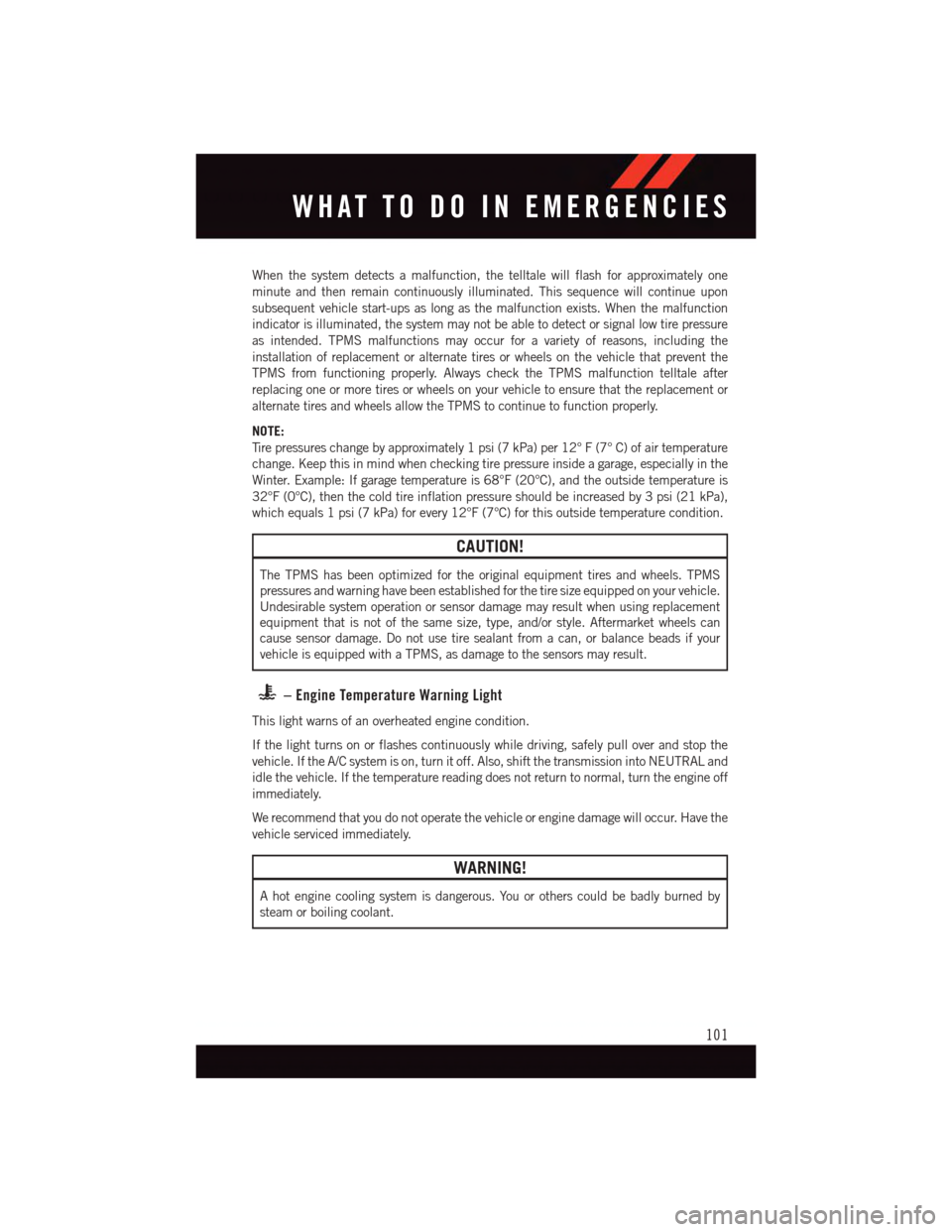
When the system detects a malfunction, the telltale will flash for approximately one
minute and then remain continuously illuminated. This sequence will continue upon
subsequent vehicle start-ups as long as the malfunction exists. When the malfunction
indicator is illuminated, the system may not be able to detect or signal low tire pressure
as intended. TPMS malfunctions may occur for a variety of reasons, including the
installation of replacement or alternate tires or wheels on the vehicle that prevent the
TPMS from functioning properly. Always check the TPMS malfunction telltale after
replacing one or more tires or wheels on your vehicle to ensure that the replacement or
alternate tires and wheels allow the TPMS to continue to function properly.
NOTE:
Ti r e p r e s s u r e s c h a n g e b y a p p r o x i m a t e l y 1 p s i ( 7 k P a ) p e r 1 2 ° F ( 7 ° C ) o f a i r t e m p e r a t u r e
change. Keep this in mind when checking tire pressure inside a garage, especially in the
Winter. Example: If garage temperature is 68°F (20°C), and the outside temperature is
32°F (0°C), then the cold tire inflation pressure should be increased by 3 psi (21 kPa),
which equals 1 psi (7 kPa) for every 12°F (7°C) for this outside temperature condition.
CAUTION!
The TPMS has been optimized for the original equipment tires and wheels. TPMS
pressures and warning have been established for the tire size equipped on your vehicle.
Undesirable system operation or sensor damage may result when using replacement
equipment that is not of the same size, type, and/or style. Aftermarket wheels can
cause sensor damage. Do not use tire sealant from a can, or balance beads if your
vehicle is equipped with a TPMS, as damage to the sensors may result.
–EngineTemperatureWarningLight
This light warns of an overheated engine condition.
If the light turns on or flashes continuously while driving, safely pull over and stop the
vehicle. If the A/C system is on, turn it off. Also, shift the transmission into NEUTRAL and
idle the vehicle. If the temperature reading does not return to normal, turn the engine off
immediately.
We recommend that you do not operate the vehicle or engine damage will occur. Have the
vehicle serviced immediately.
WARNING!
Ahotenginecoolingsystemisdangerous.Youorotherscouldbebadlyburnedby
steam or boiling coolant.
WHAT TO DO IN EMERGENCIES
101
Page 106 of 148
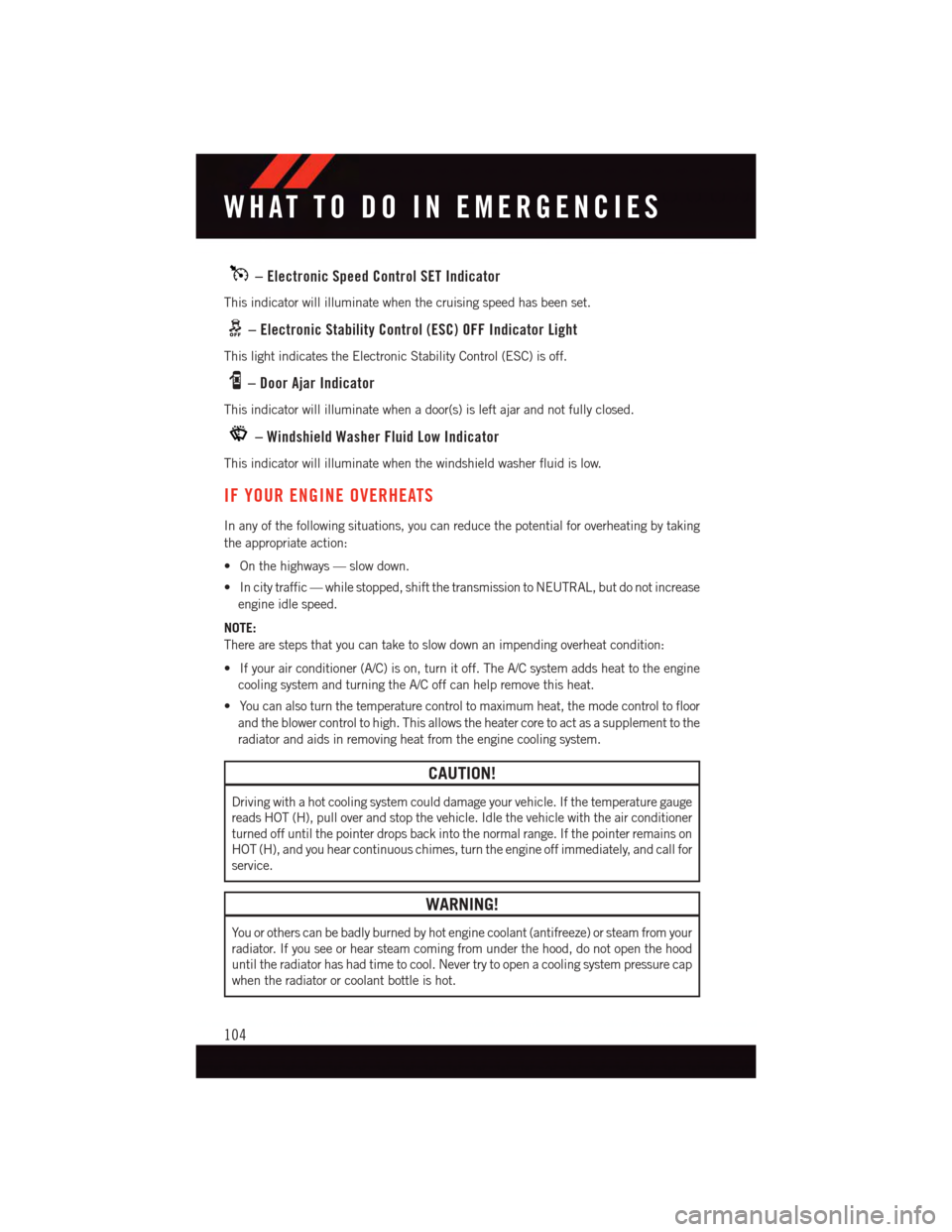
–ElectronicSpeedControlSETIndicator
This indicator will illuminate when the cruising speed has been set.
–ElectronicStabilityControl(ESC)OFFIndicatorLight
This light indicates the Electronic Stability Control (ESC) is off.
–DoorAjarIndicator
This indicator will illuminate when a door(s) is left ajar and not fully closed.
–WindshieldWasherFluidLowIndicator
This indicator will illuminate when the windshield washer fluid is low.
IF YOUR ENGINE OVERHEATS
In any of the following situations, you can reduce the potential for overheating by taking
the appropriate action:
•Onthehighways—slowdown.
•Incitytraffic—whilestopped,shiftthetransmissiontoNEUTRAL,butdonotincrease
engine idle speed.
NOTE:
There are steps that you can take to slow down an impending overheat condition:
•Ifyourairconditioner(A/C)ison,turnitoff.TheA/Csystemaddsheattotheengine
cooling system and turning the A/C off can help remove this heat.
•Youcanalsoturnthetemperaturecontroltomaximumheat,themodecontroltofloor
and the blower control to high. This allows the heater core to act as a supplement to the
radiator and aids in removing heat from the engine cooling system.
CAUTION!
Driving with a hot cooling system could damage your vehicle. If the temperature gauge
reads HOT (H), pull over and stop the vehicle. Idle the vehicle with the air conditioner
turned off until the pointer drops back into the normal range. If the pointer remains on
HOT (H), and you hear continuous chimes, turn the engine off immediately, and call for
service.
WARNING!
Yo u o r o t h e r s c a n b e b a d l y b u r n e d b y h o t e n g i n e c o o l a n t ( a n t i f r e e z e ) o r s t e a m f r o m y o u r
radiator. If you see or hear steam coming from under the hood, do not open the hood
until the radiator has had time to cool. Never try to open a cooling system pressure cap
when the radiator or coolant bottle is hot.
WHAT TO DO IN EMERGENCIES
104
Page 114 of 148
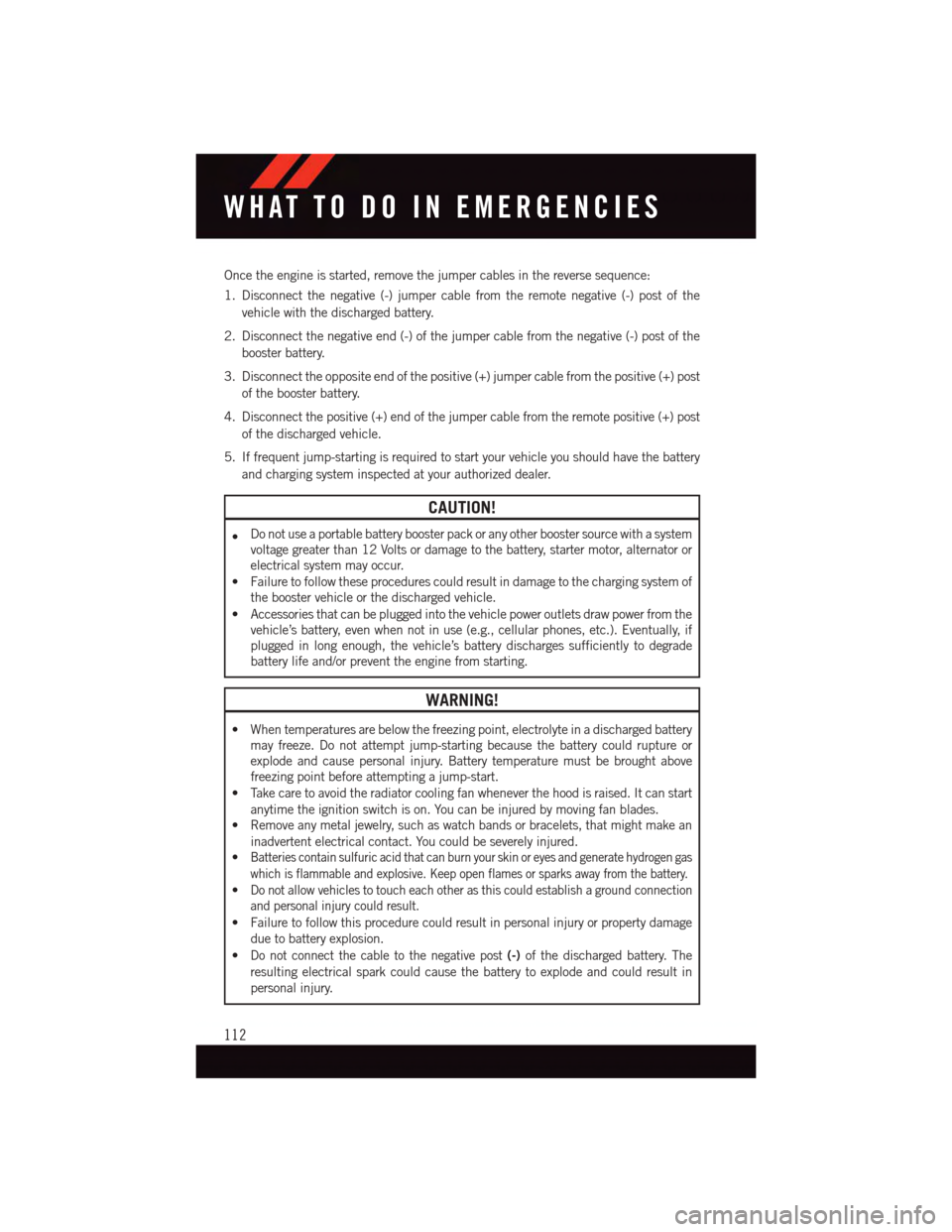
Once the engine is started, remove the jumper cables in the reverse sequence:
1. Disconnect the negative (-) jumper cable from the remote negative (-) post of the
vehicle with the discharged battery.
2. Disconnect the negative end (-) of the jumper cable from the negative (-) post of the
booster battery.
3. Disconnect the opposite end of the positive (+) jumper cable from the positive (+) post
of the booster battery.
4. Disconnect the positive (+) end of the jumper cable from the remote positive (+) post
of the discharged vehicle.
5. If frequent jump-starting is required to start your vehicle you should have the battery
and charging system inspected at your authorized dealer.
CAUTION!
•Do not use a portable battery booster pack or any other booster source with a system
voltage greater than 12 Volts or damage to the battery, starter motor, alternator or
electrical system may occur.
•Failuretofollowtheseprocedurescouldresultindamagetothechargingsystemof
the booster vehicle or the discharged vehicle.
•Accessoriesthatcanbepluggedintothevehiclepoweroutletsdrawpowerfromthe
vehicle’s battery, even when not in use (e.g., cellular phones, etc.). Eventually, if
plugged in long enough, the vehicle’s battery discharges sufficiently to degrade
battery life and/or prevent the engine from starting.
WARNING!
•Whentemperaturesarebelowthefreezingpoint,electrolyteinadischargedbattery
may freeze. Do not attempt jump-starting because the battery could rupture or
explode and cause personal injury. Battery temperature must be brought above
freezing point before attempting a jump-start.
•Takecaretoavoidtheradiatorcoolingfanwheneverthehoodisraised.Itcanstart
anytime the ignition switch is on. You can be injured by moving fan blades.
•Removeanymetaljewelry,suchaswatchbandsorbracelets,thatmightmakean
inadvertent electrical contact. You could be severely injured.
•Batteries contain sulfuric acid that can burn your skin or eyes and generate hydrogen gas
which is flammable and explosive. Keep open flames or sparks away from the battery.
•Do not allow vehicles to touch each other as this could establish a ground connection
and personal injury could result.
•Failuretofollowthisprocedurecouldresultinpersonalinjuryorpropertydamage
due to battery explosion.
•Do not connect the cable to the negative post(-)of the discharged battery. The
resulting electrical spark could cause the battery to explode and could result in
personal injury.
WHAT TO DO IN EMERGENCIES
112
Page 120 of 148
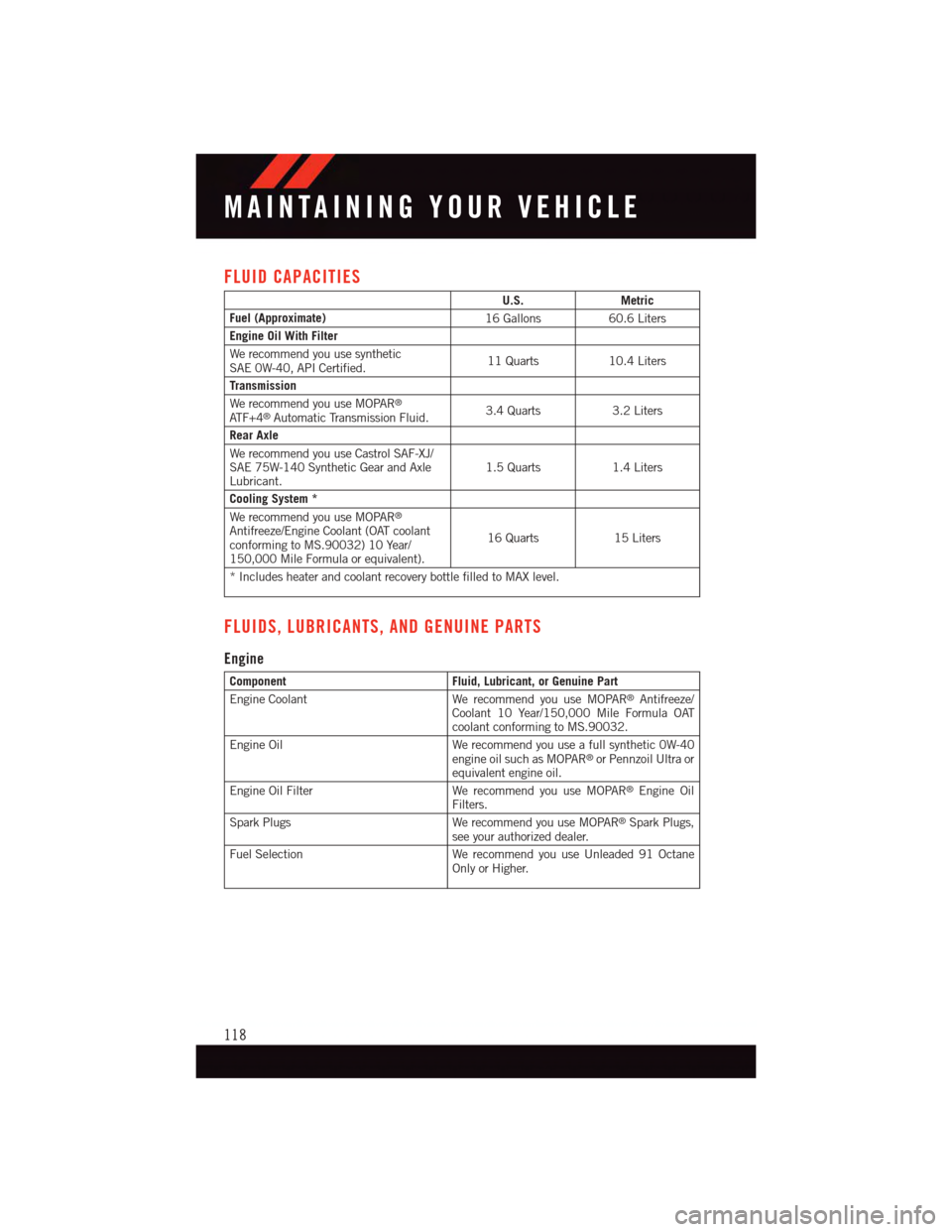
FLUID CAPACITIES
U.S.Metric
Fuel (Approximate)16 Gallons60.6 Liters
Engine Oil With Filter
We recommend you use syntheticSAE 0W-40, API Certified.11 Quarts10.4 Liters
Transmission
We recommend you use MOPAR®
AT F + 4®Automatic Transmission Fluid.3.4 Quarts3.2 Liters
Rear Axle
We recommend you use Castrol SAF-XJ/SAE 75W-140 Synthetic Gear and AxleLubricant.1.5 Quarts1.4 Liters
Cooling System *
We recommend you use MOPAR®
Antifreeze/Engine Coolant (OAT coolantconforming to MS.90032) 10 Year/150,000 Mile Formula or equivalent).
16 Quarts 15 Liters
*IncludesheaterandcoolantrecoverybottlefilledtoMAXlevel.
FLUIDS, LUBRICANTS, AND GENUINE PARTS
Engine
ComponentFluid, Lubricant, or Genuine Part
Engine CoolantWe recommend you use MOPAR®Antifreeze/Coolant 10 Year/150,000 Mile Formula OATcoolant conforming to MS.90032.
Engine OilWe recommend you use a full synthetic 0W-40engine oil such as MOPAR®or Pennzoil Ultra orequivalent engine oil.
Engine Oil FilterWe recommend you use MOPAR®Engine OilFilters.
Spark Plugs We recommend you use MOPAR®Spark Plugs,see your authorized dealer.
Fuel Selection We recommend you use Unleaded 91 OctaneOnly or Higher.
MAINTAINING YOUR VEHICLE
118
Page 121 of 148
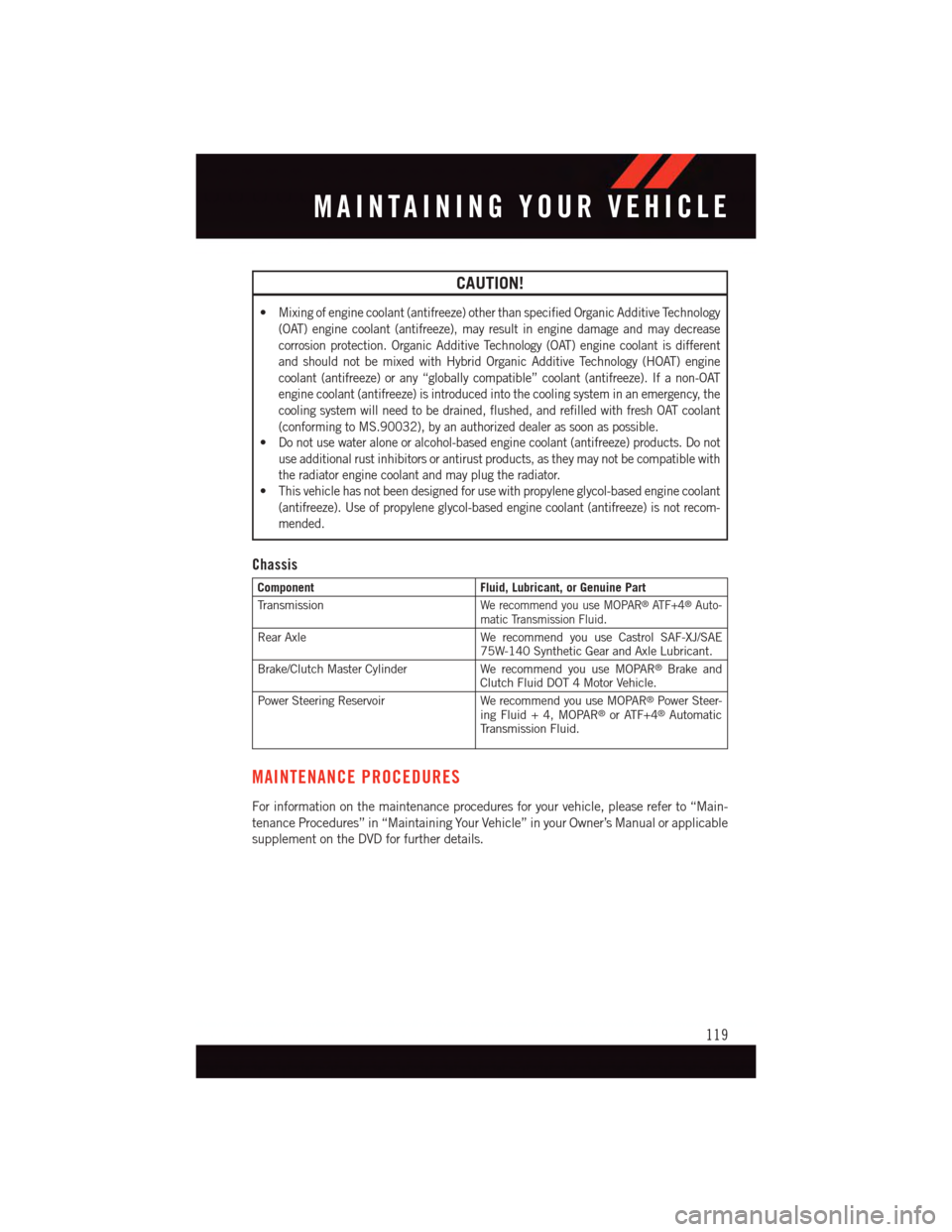
CAUTION!
•Mixing of engine coolant (antifreeze) other than specified Organic Additive Technology
(OAT) engine coolant (antifreeze), may result in engine damage and may decrease
corrosion protection. Organic Additive Technology (OAT) engine coolant is different
and should not be mixed with Hybrid Organic Additive Technology (HOAT) engine
coolant (antifreeze) or any “globally compatible” coolant (antifreeze). If a non-OAT
engine coolant (antifreeze) is introduced into the cooling system in an emergency, the
cooling system will need to be drained, flushed, and refilled with fresh OAT coolant
(conforming to MS.90032), by an authorized dealer as soon as possible.
•Do not use water alone or alcohol-based engine coolant (antifreeze) products. Do not
use additional rust inhibitors or antirust products, as they may not be compatible with
the radiator engine coolant and may plug the radiator.
•This vehicle has not been designed for use with propylene glycol-based engine coolant
(antifreeze). Use of propylene glycol-based engine coolant (antifreeze) is not recom-
mended.
Chassis
ComponentFluid, Lubricant, or Genuine Part
Tr a n s m i s s i o nWe recommend you use MOPAR®AT F + 4®Auto-matic Transmission Fluid.
Rear AxleWe recommend you use Castrol SAF-XJ/SAE75W-140 Synthetic Gear and Axle Lubricant.
Brake/Clutch Master CylinderWe recommend you use MOPAR®Brake andClutch Fluid DOT 4 Motor Vehicle.
Power Steering Reservoir We recommend you use MOPAR®Power Steer-ing Fluid + 4, MOPAR®or ATF+4®AutomaticTr a n s m i s s i o n F l u i d .
MAINTENANCE PROCEDURES
For information on the maintenance procedures for your vehicle, please refer to “Main-
tenance Procedures” in “Maintaining Your Vehicle” in your Owner’s Manual or applicable
supplement on the DVD for further details.
MAINTAINING YOUR VEHICLE
119
Page 136 of 148
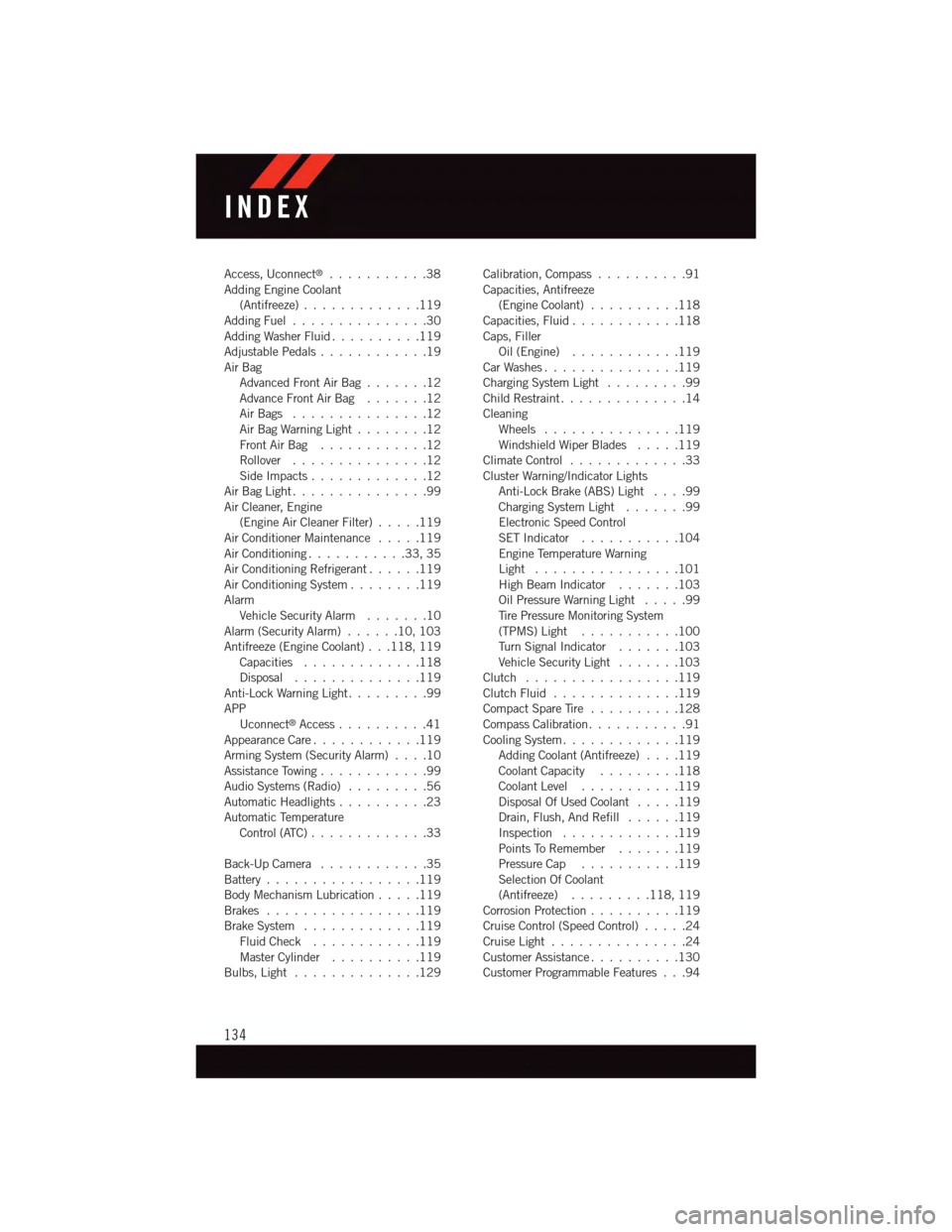
Access, Uconnect®...........38Adding Engine Coolant(Antifreeze).............119Adding Fuel...............30Adding Washer Fluid..........119Adjustable Pedals............19Air BagAdvanced Front Air Bag.......12Advance Front Air Bag.......12Air Bags . . . . . . . . . . . . . . .12Air Bag Warning Light . . . . . . . .12Front Air Bag . . . . . . . . . . . .12Rollover . . . . . . . . . . . . . . .12Side Impacts.............12Air Bag Light . . . . . . . . . . . . . . .99Air Cleaner, Engine(Engine Air Cleaner Filter).....119Air Conditioner Maintenance.....119Air Conditioning...........33,35Air Conditioning Refrigerant......119Air Conditioning System........119AlarmVehicle Security Alarm.......10Alarm (Security Alarm)......10,103Antifreeze (Engine Coolant) . . .118, 119Capacities.............118Disposal . . . . . . . . . . . . . .119Anti-Lock Warning Light.........99APPUconnect®Access..........41Appearance Care............119Arming System (Security Alarm)....10Assistance Towing............99Audio Systems (Radio).........56Automatic Headlights..........23Automatic TemperatureControl (ATC) . . . . . . . . . . . . .33
Back-Up Camera............35Battery.................119Body Mechanism Lubrication.....119Brakes . . . . . . . . . . . . . . . . .119Brake System.............119Fluid Check............119Master Cylinder..........119Bulbs, Light . . . . . . . . . . . . . .129
Calibration, Compass..........91Capacities, Antifreeze(Engine Coolant)..........118Capacities, Fluid............118Caps, FillerOil (Engine)............119Car Washes . . . . . . . . . . . . . . .119Charging System Light.........99Child Restraint..............14CleaningWheels...............119Windshield Wiper Blades.....119Climate Control . . . . . . . . . . . . .33Cluster Warning/Indicator LightsAnti-Lock Brake (ABS) Light....99Charging System Light.......99Electronic Speed ControlSET Indicator . . . . . . . . . . .104Engine Temperature WarningLight . . . . . . . . . . . . . . . .101High Beam Indicator.......103Oil Pressure Warning Light . . . . .99Ti r e P r e s s u r e M o n i t o r i n g S y s t e m(TPMS) Light...........100Tu r n S i g n a l I n d i c a t o r.......103Vehicle Security Light.......103Clutch . . . . . . . . . . . . . . . . .119Clutch Fluid . . . . . . . . . . . . . .119Compact Spare Tire..........128Compass Calibration...........91Cooling System . . . . . . . . . . . . .119Adding Coolant (Antifreeze)....119Coolant Capacity.........118Coolant Level...........119Disposal Of Used Coolant.....119Drain, Flush, And Refill......119Inspection . . . . . . . . . . . . .119Points To Remember.......119Pressure Cap . . . . . . . . . . .119Selection Of Coolant(Antifreeze).........118, 119Corrosion Protection . . . . . . . . . .119Cruise Control (Speed Control).....24Cruise Light . . . . . . . . . . . . . . .24Customer Assistance..........130Customer Programmable Features . . .94
INDEX
134
Page 137 of 148
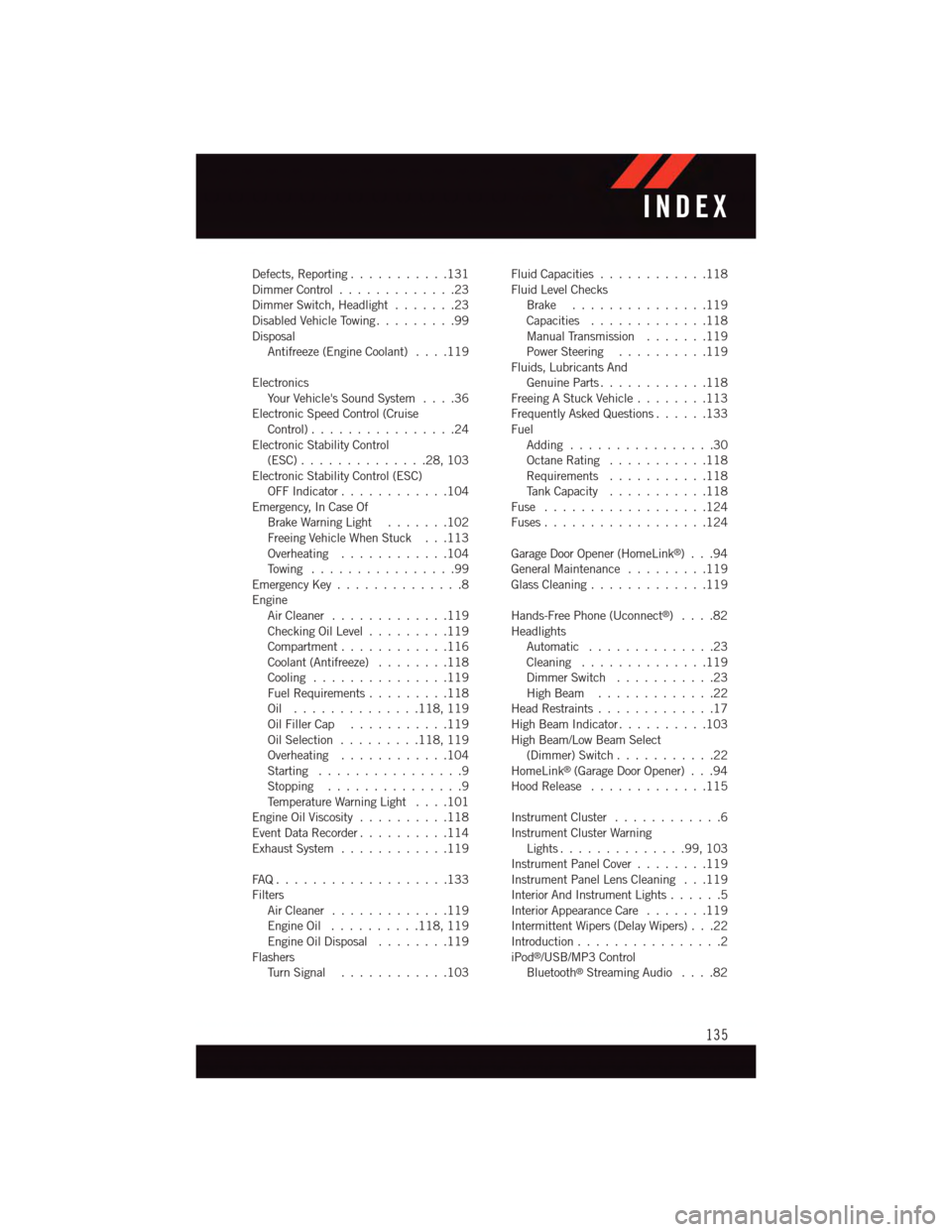
Defects, Reporting...........131Dimmer Control.............23Dimmer Switch, Headlight.......23Disabled Vehicle Towing . . . . . . . . .99DisposalAntifreeze (Engine Coolant)....119
ElectronicsYo u r Ve h i c l e ' s S o u n d S y s t e m....36Electronic Speed Control (CruiseControl) . . . . . . . . . . . . . . . .24Electronic Stability Control(ESC)..............28,103Electronic Stability Control (ESC)OFF Indicator . . . . . . . . . . . .104Emergency, In Case OfBrake Warning Light . . . . . . .102Freeing Vehicle When Stuck . . .113Overheating . . . . . . . . . . . .104To w i n g . . . . . . . . . . . . . . . . 9 9Emergency Key..............8EngineAir Cleaner.............119Checking Oil Level.........119Compartment............116Coolant (Antifreeze)........118Cooling . . . . . . . . . . . . . . .119Fuel Requirements.........118Oil . . . . . . . . . . . . . .118, 119Oil Filler Cap...........119Oil Selection . . . . . . . . .118, 119Overheating . . . . . . . . . . . .104Starting................9Stopping...............9Te m p e r a t u r e W a r n i n g L i g h t....101Engine Oil Viscosity..........118Event Data Recorder..........114Exhaust System............119
FA Q . . . . . . . . . . . . . . . . . . . 1 3 3FiltersAir Cleaner.............119Engine Oil..........118, 119Engine Oil Disposal........119FlashersTu r n S i g n a l............103
Fluid Capacities............118Fluid Level ChecksBrake . . . . . . . . . . . . . . .119Capacities.............118Manual Transmission.......119Power Steering..........119Fluids, Lubricants AndGenuine Parts............118Freeing A Stuck Vehicle . . . . . . . .113Frequently Asked Questions......133FuelAdding................30Octane Rating . . . . . . . . . . .118Requirements...........118Ta n k C a p a c i t y...........118Fuse . . . . . . . . . . . . . . . . . .124Fuses . . . . . . . . . . . . . . . . . .124
Garage Door Opener (HomeLink®)...94General Maintenance.........119Glass Cleaning.............119
Hands-Free Phone (Uconnect®)....82HeadlightsAutomatic . . . . . . . . . . . . . .23Cleaning..............119Dimmer Switch...........23High Beam.............22Head Restraints.............17High Beam Indicator..........103High Beam/Low Beam Select(Dimmer) Switch...........22HomeLink®(Garage Door Opener) . . .94Hood Release.............115
Instrument Cluster............6Instrument Cluster WarningLights . . . . . . . . . . . . . .99, 103Instrument Panel Cover........119Instrument Panel Lens Cleaning . . .119Interior And Instrument Lights......5Interior Appearance Care.......119Intermittent Wipers (Delay Wipers) . . .22Introduction................2iPod®/USB/MP3 ControlBluetooth®Streaming Audio....82
INDEX
135